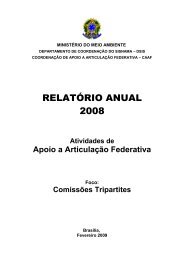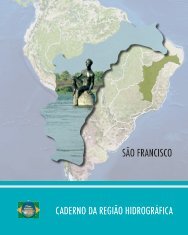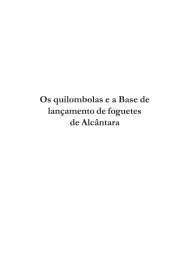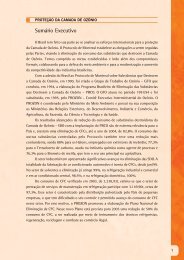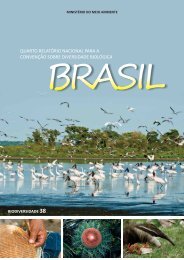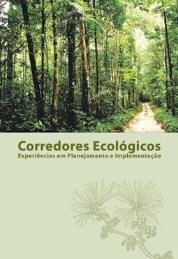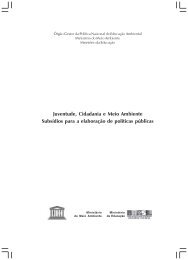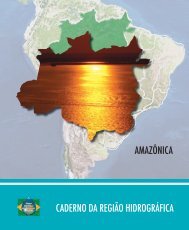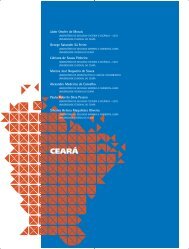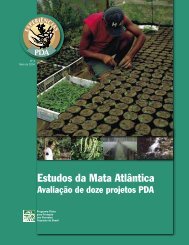Invasive Alien Species andBiosafety of GMOsAlien Invasive SpeciesBrazil is known as one of the countrieswith the greatest biodiversity in the world.It is placed first on the list of megadiversecountries. Between 15 and 20% of allspecies are contained within Brazilianterritory, in the continental platform, inthe territorial oceans, and in the exclusiveeconomic zone. All of this biodiversityis related to the great geographic andclimate diversity, the size of the territoryand the presence of the largest tropicalforest coverage in the world.There is, however, a series of factors thatthreaten the integrity and equilibrium ofthe several ecosystems in the Brazilianterritory. Among these we highlight thebiological invasions caused by invasiveexotic species which are currentlyconsidered the seconds biggest causefor biodiversity loss, only losing to thedestruction of habitats resulting fromthe direct conversion of land to humanuse and which involves deforestationand change to land use. Invasiveexotic species have a high potential fordispersion, colonization and dominanceover the invaded environments. As aresult, they generate much pressure onnative species and sometimes lead totheir extinction.Increasing globalization, enlargementof roads and highways, increasedinternational commerce and tourism, inaddition to the climate changes resultingfrom the greenhouse effect, tend tosignificantly boost the opportunities forthe introduction and expansion of invasiveexotic species into various ecosystems ofthe Earth.Given Brazil’s continental dimension,which includes land frontiers with 10countries, a coastal frontier with anextension of over 7000km and the riversthat enter the country, the entrance ofexotic species that can become invasiveis very easy. This ease of entrance directlyimpacts in the conservation of nativeand agricultural biodiversity, as well ason the economic and social impactsresulting from problems created for theagricultural, silvicultural and livestockproduction systems. The cost for thecountry reaches tens of billions of USdollars.79
The MMA acknowledges the problemspertaining to biological invasions and is inclose articulation with different segmentsof society. With this, it has beendeveloping a series of measures focusedon: (i) prevention of introduction; (ii) earlydetection; (iii) monitoring; (iv) control/ management and; (v) eradication.These measures basically regard the:creation of norms, as for example theConama (National Environmental Council)Resolutions; incentives to the creationof discussion forums in the scope offederal units; surveying registries of exoticspecies and biological invasion in thevarious ecosystems; facilitating researchcredit; supporting the elaboration andpublication of official lists of nationaland state exotic invasive species and;supporting the adoption of measures forthe eradication of exotic invasive speciesin protected area sites.As regards the marine environment,Brazilian measures in this area beganin 2000 with the Global BallastWater Management Programme. ThisProgramme involves various countries(Brazil, China, India, Iran, South Africaand Ukraine) and its focal point in Brazilwas the Ministry of the Environment,which counted on support from theProgram for the Integrated Managementof the Coastal and Marine Environments(Gercom).As regards land environments andcontinental waters, the Brazilianmeasures began in 2001 on the occasionof the Work Meeting on Invasive ExoticSpecies, held jointly by the BrazilianMinistry of the Environment andthe Brazilian Agricultural ResearchCorporation. This meeting counted onthe participation of representativesfrom Argentina, Bolivia, Brazil, Chile,Colombia, Ecuador, French Guyana,Paraguay, Peru, Suriname, Uruguay andVenezuela.As a result of the meeting, the MMAthrough the Project on the Conservationand Sustainable Use of the BrazilianBiological Diversity (Projeto deConservação e Utilização Sustentávelda Diversidade Biológica Brasileira- Probio) and the National Fund for theEnvironment (Fundo Nacional do MeioAmbiente – FNMA), calls for proposalswere launched and sub-projects forthe management of plant and animalspecies considered to be invasive in thenational territory were selected. ThroughAdministrative Decree 494 of August2003, the Minister for the Environmentcreated the National Task Force for theControl of the Limnoperna fortunei (afreshwater mussel).Still in 2003, in light of the precariousbibliographical references and research inBrazil pertaining to the matter, the MMAlaunched a public consultation for thefirst National Inform on Invasive ExoticSpecies. There were two diagnostics– one about current and potential invasiveexotic species and another about thecountry’s installed capacity to addressthe matter. The surveys address thespecies that affect land environmentsand continental waters and the coastalzone, as well as those that affectproduction systems and human health.This initiative was finalized in 2005 onthe occasion of the meeting on whichresults and assessments of final reportswere presented. Five hundred forty threespecies considered to be invasive exoticto the different Brazilian ecosystems wereregistered.By means of the Brazilian Marine’sDirectory of Ports and CoastsAdministrative Decree 52, of June2005, the Maritime Authority’s Normfor the Management of Ships BallastWaters was issued. Ship ballast watersare one of the greatest vectors for the80



